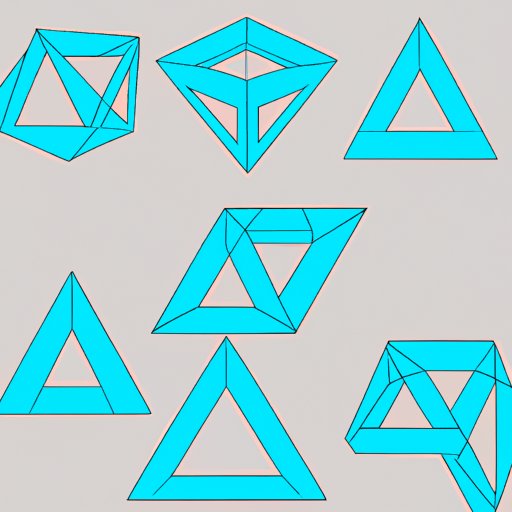Introduction
Vertices are essential components of geometry and mathematical modeling. It is important to understand the concept of vertices in mathematics as they have practical applications in real-world problems. In this article, we will explore the definition of vertices, types of vertices, how to identify and plot vertices, and the relationship between vertices, edges, and faces in shapes.
The Cornerstones of a Triangle: Understanding Vertices in Math
A vertex is a point where two or more lines or edges meet in a shape. Vertices are also known as corner points, and shapes can have varying numbers of vertices. Understanding the concept of vertices is particularly important in geometry, as it helps in understanding the relationship between shapes, angles, and lines.
There are different types of vertices in geometry. A convex vertex is one where the angle between the intersecting lines is less than 180 degrees. A concave vertex, on the other hand, is one where the angle between the intersecting lines is greater than 180 degrees.
One example of a vertex in geometry is in a triangle. A triangle has three vertices where three edges meet. The three vertices of a triangle are commonly denoted as A, B, and C. Understanding the positions of the vertices can help in calculating the area, perimeter, and angles of the triangle.
Finding Your Point: A Comprehensive Guide to Vertices in Geometry
Finding vertices in shapes is an essential step in geometry. In two-dimensional space, a vertex can be found by locating the intersection of two or more lines. In three-dimensional space, vertices can be found using more complex methods such as using a cross-sectional analysis or by inspecting the edges of the shape.
For example, finding vertices in a square can be done by locating the intersection of two pairs of perpendicular lines. In a cube, vertices can be found at the eight corners of the cuboid.
Unpacking the Definition of a Vertex in Math: How It Relates to Shapes and Graphs
Vertices have an important connection to graphs. In graph theory, vertices are used to represent a point in a graph, with edges connecting the vertices to show a relationship between the points.
A vertex in a parabola is also an essential concept in understanding functions. In the function y = ax^2 + bx + c, the vertex is the lowest or highest point on the graph of the function. The vertex of a parabola occurs at (-b/2a, f(-b/2a)).
Visualizing Vertices: How to Identify and Plot Points in 2D and 3D Space
Identifying and plotting vertices is an essential part of geometry. In two-dimensional space, vertices can be plotted on a graph by assigning coordinates to the point of intersection between two lines. In three-dimensional space, vertices can be plotted by assigning coordinates to the point where three or more edges meet in a shape.
For example, to plot the vertices of a cube on a graph, we would assign coordinates to the eight corners of the cube. These coordinates can be expressed as (±1, ±1, ±1).
Mastering Vertex Concepts: Exploring the Relationship Between Vertices, Edges, and Faces
The relationship between vertices, edges, and faces is an essential concept in geometry. A face is a flat surface on a 3D shape, and an edge is the intersection between two faces. The number of faces, edges, and vertices in a shape is related by Euler’s formula: F + V – E = 2. Where F, V, and E denote faces, vertices, and edges respectively.
For example, in a cube, there are six faces, twelve edges, and eight vertices. When we substitute these values into Euler’s formula, we get 6 + 8 – 12 = 2. Hence verifying that Euler’s formula holds for the cube.
Why it Matters: The Role of a Vertex in Mathematical Modeling and Analysis
Vertices are essential in mathematical modeling and analysis. They are used in various fields such as computer science, physics, engineering, and economics. For example, vertices are used in computer graphics to represent 3D models of objects, and in physics to model the structure of molecules and atoms.
Furthermore, vertices are important in mathematical modeling as they can be used to represent decision points or nodes in optimization models, such as in the traveling salesman problem.
Conclusion
Vertices are an essential concept in math, particularly in geometry and mathematical modeling. Understanding vertices can help in calculating the area, perimeter, and angles of shapes and can aid in solving real-world problems. The relationship between vertices, edges, and faces is also critical in understanding the structure of shapes. By exploring the concept of vertices in this article, we hope that you now have a better understanding of this fundamental mathematical concept.
